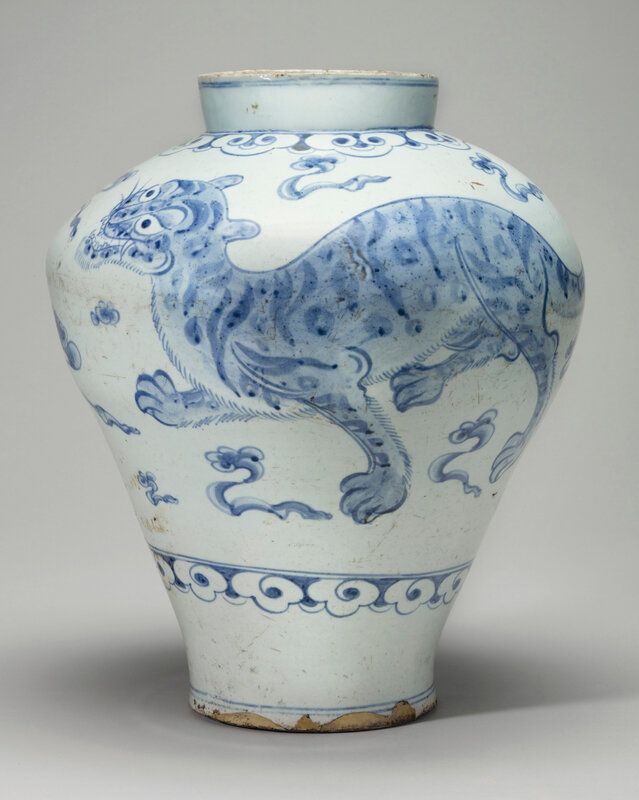The ovoid form, vividly painted in underglaze-blue with a tiger and mythical lion (haetae), and clusters of scalloped clouds interspersed with smaller cloud ribbons, the neck and lower body with auspicious fungus-head-shaped cloud collars, the body applied with a lustrous transparent overglaze.
The jar’s form doubtless finds distant inspiration in meiping vessels created in China during the Northern Song period (960–1127). Despite the poetic name meaning “plum vase”, meiping (Korean, maebyeong) vessels were not vases for the display of cut branches of blossoming plum but were elegant storage bottles for wine and other liquids. Korean potters of the twelfth and thirteenth centuries, during the Goryeo dynasty (918–1392), gave the maebyeong form its classic interpretation, with broad shoulders, narrow waist, and lightly flaring foot. In fact, the graceful Goryeo interpretation of the maebyeong echoes in meiping vessels created in China from the fifteenth century onward, during the Ming (1368–1644) and Qing (1644–1911) dynasties.
Crafted in both porcelain and buncheong stoneware, the maebyeong form persisted into the Joseon dynasty (1392–1910), following its own evolutionary path. Dated by inscription to 1489, a monumental blue-and-white porcelain jar with pine and bamboo décor in the collection of Dongguk University Museum, Seoul (National Treasure no. 176; See:In Blue and White: Porcelain of the Joseon Dynasty, Seoul: National Museum of Korea, 2015, p. 14, no. 3), reveals that by the late fifteenth-century the maebyeong vessel had been transformed from slender-necked bottle into wide-mouthed jar; it further reveals that in the transformation from bottle to jar, such vessels saw both an increase in size and a change in proportions, the shoulder becoming ever broader, probably to accommodate the wider mouth. As evinced by a porcelain jar embellished with a branch of fruiting grapevine painted in underglaze iron brown, the jar now in the collection of Ewha Women’s University Museum, Seoul (National Treasure no. 107), seventeenth-century potters gave the jar form the robust interpretation that would continue through the end of the dynastic era. Unique to Korea, jars with bulging shoulders and gently curved side walls that descend to a constricted base were ubiquitous during the seventeenth, eighteenth, and nineteenth centuries. Formally termed jun in Korean, this jar shape is sometimes also called a “moon jar”—dal hangari ? ??? in Korean—though that name technically should be reserved for large round jars whose globular shape recalls a full moon.
Seventeenth- and early eighteenth-century examples have a short, vertical neck and an exaggerated profile, with massive shoulders and constricted waist; of closely related form, those from the second half of the eighteenth century display a less exaggerated profile that incorporates a gentle S-curve, and they have a slightly higher neck; that classic form continues into the first decades of the nineteenth century. Jars from later in the nineteenth century, by contrast, exhibit a more mannered profile with narrower shoulders, an attenuated body, a beveled foot, and a tall, cylindrical neck.
The feline face, long vertical stripes, clawed paws, and long tail identify the beast with those markings as a tiger, orhorang’i ?, which is regarded as both a guardian that wards away evil spirits and a sacred creature that brings good fortune. Though not one of the Four Directional Deities, or Sasin—a term referring to the mythical animals guarding the four cardinal directions: Azure Dragon of the East, White Tiger of the West, Black Tortoise-and-Serpent of the North and Vermilion Bird of the South—the tiger has long been associated with Korea and Korean culture, and it figures in Korea’s foundation mythology. In fact, the oldest Korean historical records that mention the tiger associate it with Dangun, Korea’s legendary founding father. In blue-and-white jars and folk paintings, the tiger is often shown together with a pine tree, a magpie, or both (See In Blue and White, p. 137, no. 99, and pp. 210-213, nos. 176-180); its appearance together with another auspicious creature on this jar is somewhat unusual.
The other beast, which has a beard, a spikey mane, a bushy tail, furry shoulders and knees, and a repeating pattern of circles over its body is variously identified as a lion (Korean, saja), a haetae, or simply as auspicious creature. Known in Chinese as a xiezhi, the haetae—sometimes also called a haechi in Korean—traditionally has the body of a lion but is covered with scales. In fact, the repeating pattern of circles that embellishes this animal’s coat might be read as scales. Inherently a just beast, the haetae is able to distinguish the good from the bad, and, because it is able to preserve law and order among the people, it stands as a symbol of law and justice. The haetae is traditionally described as a “righteous beast that rams the aggressive party when it sees a fight, and bites the party in the wrong when it hears an argument”. In Joseon times, haetae sculptures were believed to protect the capital from natural disasters. With their bearded faces, bushy manes and tails, and clawed paws, and coats embellished with small circles, the Joseon-period stone sculptures of haetae near Seoul’s Gyeongbok Palace resemble the beast on this blue-and-white jar, permitting its tentative identification as a haetae.
Robert D. Mowry
Alan J. Dworsky Curator of Chinese Art Emeritus,
Harvard Art Museums, and
Senior Consultant, Christie’s.

A picture of a haetae taken at a Korean palace.

/https%3A%2F%2Fprofilepics.canalblog.com%2Fprofilepics%2F1%2F0%2F100183.jpg)
/https%3A%2F%2Fstorage.canalblog.com%2F03%2F02%2F119589%2F96711876_o.jpg)
/https%3A%2F%2Fstorage.canalblog.com%2F11%2F31%2F119589%2F94773502_o.jpg)
/https%3A%2F%2Fstorage.canalblog.com%2F20%2F83%2F119589%2F94772815_o.jpg)
/https%3A%2F%2Fstorage.canalblog.com%2F26%2F72%2F119589%2F75604929_o.jpg)
/https%3A%2F%2Fstorage.canalblog.com%2F59%2F60%2F119589%2F26458628_o.jpg)






/http%3A%2F%2Fstorage.canalblog.com%2F00%2F00%2F119589%2F129758935_o.jpg)
/http%3A%2F%2Fstorage.canalblog.com%2F29%2F28%2F119589%2F129637299_o.jpg)
/http%3A%2F%2Fstorage.canalblog.com%2F88%2F37%2F119589%2F129631480_o.jpg)
/http%3A%2F%2Fstorage.canalblog.com%2F77%2F79%2F119589%2F129631259_o.jpg)